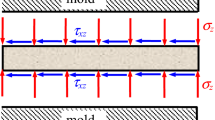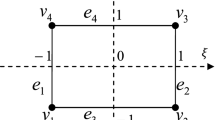Abstract
A new numerical method for solving two-dimensional arbitrarily shaped inhomogeneity problems is demonstrated in the present work. Solution is achieved through a discretization consisting of rectangular elements using newly formulated closed-form solutions. An iterative scheme for implementing the numerical equivalent inclusion method, i.e., determining the equivalent eigenstrains, is proposed. Comprehensive benchmarks on numerical convergence with respect to mesh size and iterative number are conducted to demonstrate the performance of the new numerical method. Comparative studies among results are obtained by the proposed iterative scheme, the Gaussian elimination method, and the Hutchinson approximation and show superiority of the iterative scheme. Simulations for material combinations utilizing the Dundurs α–β plane reveal its capability. A double-inhomogeneity model illustrates the ability of the new numerical method to predict the stress concentration factor for closely distributed multiple inhomogeneities.















Similar content being viewed by others
References
Stagni, L.: On the elastic field perturbation by inhomogeneities in plane elasticity. Z. Angew. Math. Phys. ZAMP 33(3), 315–325 (1982)
Mura, T.: Micromechanics of Defects in Solids, 2nd edn. Kluwer Academic, Dordrecht (1993)
Kuo, C.H.: Stress disturbances caused by the inhomogeneity in an elastic half-space subjected to contact loading. Int. J. Solids Struct. 44(3–4), 860–873 (2007)
Eshelby, J.D.: The determination of the elastic field of an ellipsoidal inclusion, and related problems. Proc. R. Soc. A, Math. Phys. Eng. Sci. 241(1226), 376–396 (1957)
Eshelby, J.D.: The elastic field outside an ellipsoidal inclusion. Proc. R. Soc. A, Math. Phys. Eng. Sci. 252(1271), 561–569 (1959)
Moschovidis, Z.A., Mura, T.: Two-ellipsoidal inhomogeneities by the equivalent inclusion method. ASME J. Appl. Mech. 42, 847–852 (1975)
Shodja, H., Rad, I., Soheilifard, R.: Interacting cracks and ellipsoidal inhomogeneities by the equivalent inclusion method. J. Mech. Phys. Solids 51(5), 945–960 (2003)
Jin, X., Keer, L.M., Wang, Q.: A closed-form solution for the Eshelby tensor and the elastic field outside an elliptic cylindrical inclusion. J. Appl. Mech. 78(3), 031009 (2011)
Muskhelishvili, N.I.: Some Basic Problems of the Mathematical Theory of Elasticity. Noordhoff, Leyden (1953)
Jin, X., Wang, Z., Zhou, Q., Keer, L.M., Wang, Q.: On the solution of an elliptical inhomogeneity in plane elasticity by the equivalent inclusion method. J. Elast. 114(1), 1–18 (2014)
Nozaki, H., Taya, M.: Elastic fields in a polyhedral inclusion with uniform eigenstrains and related problems. J. Appl. Mech. 68(3), 441–452 (2001)
Hutchinson, J.W.: Crack tip shielding by micro-cracking in brittle solids. Acta. Metall. 35(7), 1605–1619 (1987)
Shi, J., Li, Z.: An approximate solution of the interaction between an edge dislocation and an inclusion of arbitrary shape. Mech. Res. Commun. 33(6), 804–810 (2006)
Nakasone, Y., Nishiyama, H., Nojiri, T.: Numerical equivalent inclusion method: a new computational method for analyzing stress fields in and around inclusions of various shapes. Mater. Sci. Eng. A 285, 229–238 (2000)
Liu, S., Wang, Q.: Studying contact stress fields caused by surface tractions with a discrete convolution and fast Fourier transform algorithm. J. Tribol. 124(1), 36–45 (2002)
Liu, S., Wang, Q., Liu, G.: A versatile method of discrete convolution and FFT (DC-FFT) for contact analyses. Wear 243(1), 101–111 (2000)
Zhou, K., Keer, L.M., Wang, Q.J.: Semi-analytic solution for multiple interacting three-dimensional inhomogeneous inclusions of arbitrary shape in an infinite space. Int. J. Numer. Methods Eng. 87(7), 617–638 (2011)
Dundurs, J.: Discussion “Edge-bonded dissimilar orthogonal elastic wedges under normal and shear loading”. J. Appl. Mech. 36(3), 650–652 (1969)
Chiu, Y.P.: On the internal stresses in a half plane and a layer containing localized inelastic strains or inclusions. J. Appl. Mech. 47, 313–318 (1980)
Jin, X., Keer, L.M., Wang, Q.: New Green’s function for stress field and a note of its application in quantum-wire structures. Int. J. Solids Struct. 46(21), 3788–3798 (2009)
Kushch, V., Shmegera, S., Buryachenko, V.: Interacting elliptic inclusions by the method of complex potentials. Int. J. Solids Struct. 42(20), 5491–5512 (2005)
Acknowledgements
The authors would like to acknowledge the supports from Center for Surface Engineering and Tribology at Northwestern University, USA, and State Key Laboratory of Mechanical Transmission at Chongqing University (No. 0301002109162), China. The authors are grateful to Prof. Volodymyr Kushch for providing the source code of their paper. Qinghua Zhou would like to thank the scholarship support from China Scholarship Council (No. 2011605076). Zhanjiang Wang would also like to acknowledge the support from National Science Foundation of China under Grant No. 51105391.
Author information
Authors and Affiliations
Corresponding authors
Appendix: Analytical Solutions of Eigenstrain and Stress Concentration Factors for a Plane Medium
Appendix: Analytical Solutions of Eigenstrain and Stress Concentration Factors for a Plane Medium
The analytical solution to a plane elliptical inhomogeneity problem has derived by means of the EIM by Jin et al. [10]. The results are summarized here for convenience of reference. The equivalent eigenstrain inside the inclusion domain, i.e., for (x/a)2+(y/b)2<1,
where
The stress concentration factors are determined by the stresses at the vertices of the ellipse. At (a,0) of the matrix side
where
At (0,b) of the matrix side
where
Rights and permissions
About this article
Cite this article
Zhou, Q., Jin, X., Wang, Z. et al. Numerical Implementation of the Equivalent Inclusion Method for 2D Arbitrarily Shaped Inhomogeneities. J Elast 118, 39–61 (2015). https://doi.org/10.1007/s10659-014-9477-2
Received:
Published:
Issue Date:
DOI: https://doi.org/10.1007/s10659-014-9477-2




